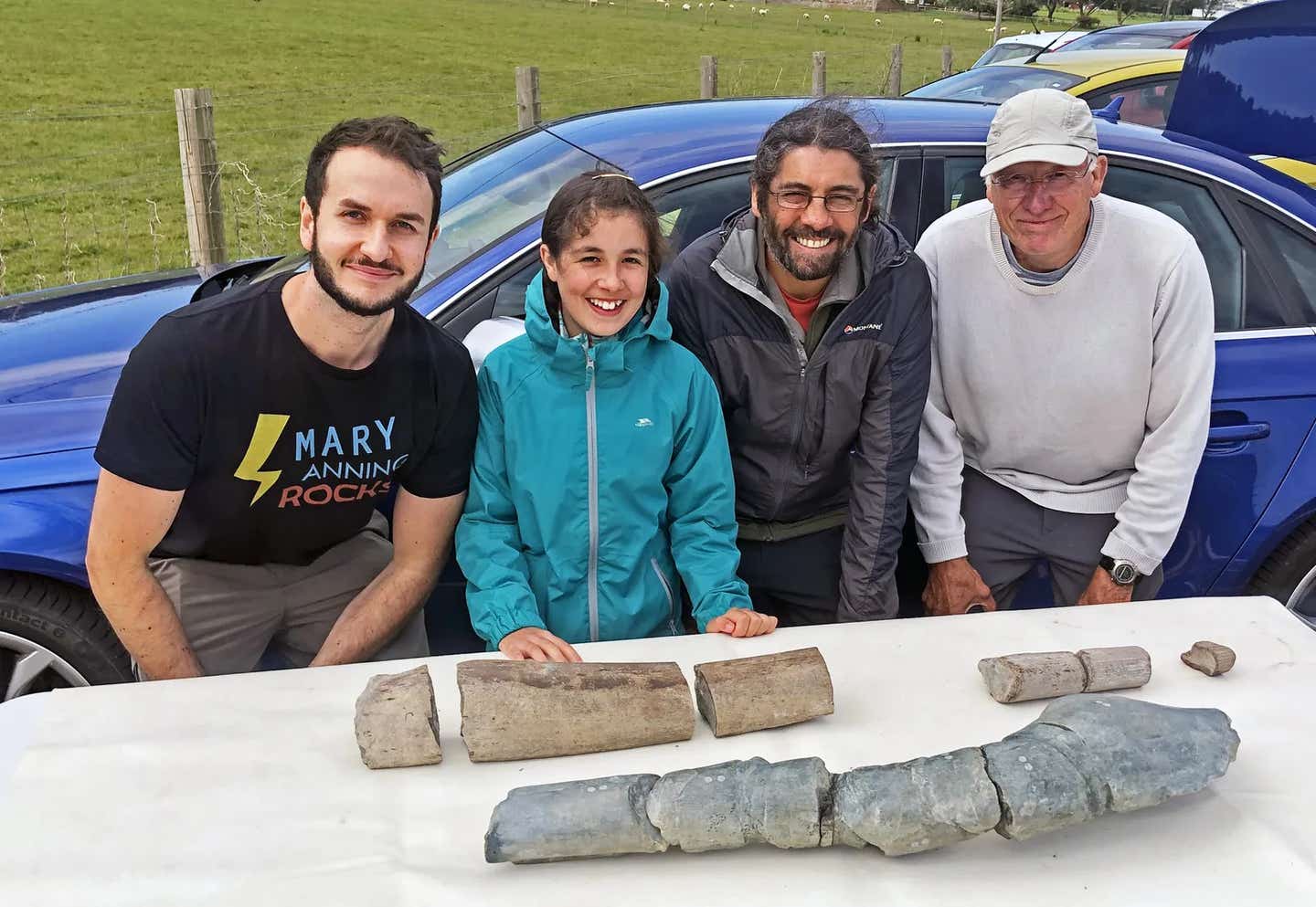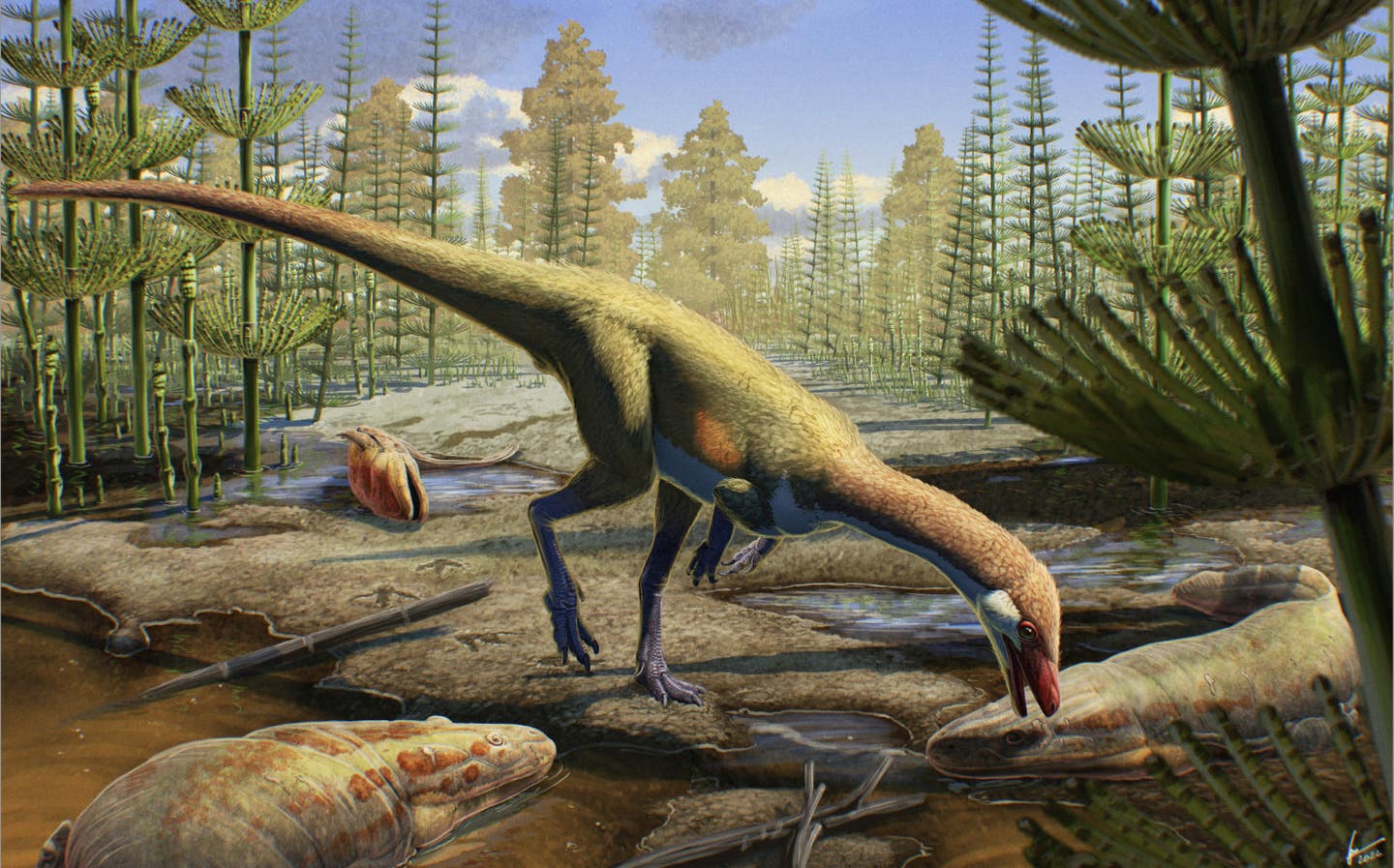11-year-old girl finds fossil of largest marine reptile ever to swim Earth’s oceans
11-year-old named Ruby Reynolds stumbled upon another ichthyosaur fossil, possibly the largest ever found by science.

(LEFT) Dean Lomax, Ruby Reynolds, Justin Reynolds and Paul de la Salle with fragments of an ichthyosaur jawbone in 2020. (CREDIT: Dean Lomax)
In 1811, Mary Anning, a 12-year-old from southwestern England, made a groundbreaking discovery on a beach near her home: the first scientifically identified ichthyosaur fossil, a marine reptile akin to a dolphin from the dinosaur era.
Fast forward two centuries, just under 50 miles away, an 11-year-old named Ruby Reynolds stumbled upon another ichthyosaur fossil, possibly the largest ever found by science.
Ruby, now 15, and her father, Justin Reynolds, have been exploring fossil-rich areas near their Braunton home in England for over a decade. Their journey took a significant turn in May 2020 during a family outing to Blue Anchor village along the River Severn estuary when they spotted a fossilized bone fragment nestled on a rock.
An illustration by artist Sergey Krasovskiy of an ichthyosaur, a dolphin-like, ocean-dwelling reptile from the time of the dinosaurs. (CREDIT: Sergey Krasovskiy)
"We were both excited as we had never found a piece of fossilized bone as big as this before," Justin Reynolds recalled. His daughter's persistence paid off when she unearthed an even larger bone fragment shortly after.
Excited by their finds, they began researching, guided by a 2018 paper detailing similar bone fragments discovered in nearby Lilstock. These fragments were speculated to be part of an ichthyosaur's jaw bone, but the specimen was considered too incomplete to classify as a new species.
Justin Reynolds reached out to the researchers behind the Lilstock discovery, Dean Lomax from the University of Bristol, and Paul de la Salle, an amateur fossil collector.
Related Stories
Together with the Reynolds family, they combed the Blue Anchor area, employing shovels to dig through the mud. Their efforts paid off when they uncovered nearly half of a bone estimated to have been over 7 feet long.
Careful examination revealed telltale features of an ichthyosaur's jaw bone. To confirm their suspicions, the team enlisted the expertise of Marcello Perillo, a paleontologist from the University of Bonn.
Microscopic analysis revealed characteristic crisscrossed collagen fibers, unique to ichthyosaurs. Surprisingly, despite its massive size, the reptile had not reached full maturity when it perished.
The nearly complete giant jawbone is shown along with the jawbone (middle and bottom) found by Paul de la Salle in 2016. (CREDIT: Dean Lomax)
The fossils from Blue Anchor and Lilstock provided compelling evidence of a significant discovery. Lomax and his collaborators, in a paper published in the journal PLOS One, christened the find "Ichthyotitan severnensis," or the giant fish lizard of the Severn.
Their estimates suggest Ichthyotitan could have measured up to 82 feet in length, rivaling the size of a blue whale and earning the title of the largest marine reptile known to science. This massive creature roamed the seas just before a catastrophic extinction that marked the end of the Triassic Period.
"Inevitably with big extinction events, it’s the big things that go first," Lomax remarked, noting the disappearance of this colossal reptile and its entire family.
Erin Maxwell, a paleontologist from the State Museum of Natural History in Stuttgart, Germany, not involved in the study, emphasized the significance of this discovery for understanding ichthyosaur evolution. "Before, there were hints of giant ichthyosaurs nearing the Triassic-Jurassic boundary, but the evidence is now becoming incontrovertible," Maxwell stated.
Lomax underscored the crucial role of amateur fossil collectors in this discovery, noting, "If you have a keen eye, if you have a passion for something like that, you can make discoveries like this."
Reflecting on her part in the scientific breakthrough, Ruby Reynolds remarked, "I didn’t realize when I first found the piece of ichthyosaur bone how important it was and what it would lead to. I think the role that young people can play in science is to enjoy the journey of exploring as you never know where a discovery may take you."
For more science stories check out our New Discoveries section at The Brighter Side of News.
Note: Materials provided above by The Brighter Side of News under a Creative Commons license. Content may be edited for style and length.
Like these kind of feel good stories? Get the Brighter Side of News' newsletter.
Joshua Shavit
Science & Technology Writer | AI and Robotics Reporter
Joshua Shavit is a Los Angeles-based science and technology writer with a passion for exploring the breakthroughs shaping the future. As a contributor to The Brighter Side of News, he focuses on positive and transformative advancements in AI, technology, physics, engineering, robotics and space science. Joshua is currently working towards a Bachelor of Science in Business Administration at the University of California, Berkeley. He combines his academic background with a talent for storytelling, making complex scientific discoveries engaging and accessible. His work highlights the innovators behind the ideas, bringing readers closer to the people driving progress.



